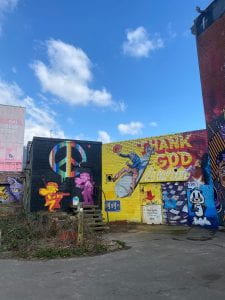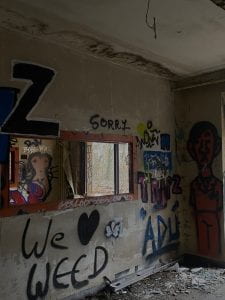The most reliable thing in the month of April seems to be the consistency of the rain. Last week, when the sun made a momentary appearance I decided to head over to Grunewald to scope out Teufelsberg. I have a fascination with abandoned things and although Teufelsberg has transformed from something forgotten into a tourism sight, it is still something I wanted to see. After the fall of the wall, Berlin became a hotspot for all things abandoned. Some argue that exploration of abandoned places stems from the desire to be performative or take a risk; people critique urban explorers who find themselves in places solely because the “forbidden is fun.” Nathen Wright, owner of the website ‘Abandoned Berlin’ counters this argument and explains, “Every crumbling building, creaking floorboard, fluttering curtain and flaking piece of paint has a tale begging to be told. Even abandonment and neglect are comforting in the face of almost certain development.” Well aware of the fates many of these buildings face, Wright urges people to respectfully explore them while it is still possible.
In 2009 Weight first began to post on ‘Abandoned Berlin.’ Now, almost fourteen years later, the website acts as an archive that exhibits many places that no longer exist. The story about a 90 year old woman who found herself stranded on top of the SpreePark Ferris wheel and the shared memories many have of one night only nightclubs inside of empty buildings have become fantastical events of the past. While some buildings have been knocked down to make room for modern development others are being restored. Spreepark was abandoned for years after closing in 2001, however, now Spreepark is a partial construction site with a short metal wall surrounding it warning people “do not enter, dogs danger to life and limb.” The reopening of Spreepark has been in process since 2014, however, its opening keeps getting rescheduled. In 2026 the park will reopen (maybe) as a place for live theater and art. The Kaiser Wilhelm Church acts as a more typical example of how historic sites are saved from becoming abandoned rubbish. Due to the air raids in 1943, the roof collapsed, and “ At the end of the war, the Allies were unwilling to rebuild it, since it had been a symbol of excessive national pride.” For years the ruined building stood as a reminder of the horrors of war. In 1961 architect Egon Eirmann created a design to restore the building, leaving the destruction of its roof still visible, now the church stands as a symbol of reconciliation. The East Side Gallery models the interplay between commemoration and artistic expression. On the border of Kreuzberg, this is the longest section of the wall and displays the art of 118 artists from 21 different countries. With more than 3 million visitors per year, the east die gallery stands as “a monument to the fall of the Berlin Wall and the peaceful negotiation of borders and conventions between societies and people.” Many visit the gallery to see well-known works like the two politicians kissing and Heimler’s “the wall jumper,” however, the gallery as a whole act as a model for how something that once was abandoned can become an active and important piece of culture today.


(East Side Gallery)

(The Kaiser Wilhelm Church)
Teufelsberg combines many of the different approaches people have taken when dealing with abandoned or historic property. In order to get to the massive spy station you have to walk on a trail through the woods. As I approached I talked to my friend about how thankful I was to be in nature, unaware of the fact the hill I was climbing was entirely man-made. Lying beneath the 120-meter-high hill are the remains of a Nazi-planned military training school designed by Albert Speer. At the conclusion of the war, the Allies made an attempt to destroy the military training school with explosives and failed. Instead of trying to bomb the academy again, people made the decision to cover it with rubble. It is said that every day “80 truckloads of 7,000 cubic meters of rubble collected mostly by local women used to arrive.” Because many men lost their lives or were imprisoned after the war, women became known as trümmerfrauen or ‘rubble women,” and were essential in helping clear debris and restore damage. In 1972 the dumping of rubble stopped and trees were planted to make the hill more “attractive.”








(Teufelsberg)
During the cold war (1950 onward) the hill was used by the US as a spy station. Five domes were built, each continuing a “12-meter satellite antenna and the most sophisticated spying equipment for the time, enabling the Western powers to intercept satellite signals and radio waves’ ‘ allowing them to learn what was going on in the Russian-controlled East. In 1992 this station was abandoned by American forces and was used for two years to control air traffic. In 1996 Hartmut Gruhl and Hanfried Schüte bought the property with plans to build apartments, a hotel, restaurant, and spy museum. After this failed to happen they sold the sight to American filmmaker, David Lynch, who wanted to build “Peace University” and open a yoga retreat. When the city rejected his proposal to build a “tower of invincibility”, the property was again sold to Shalmon Abraham. In 2011, Abraham began to invite street artists to decorate the domes and charge the general public admission to enter the site. The work began to attract many people to visit, allowing Abraham to make large monetary profits. Today, people continue to visit Teufelsberg and pay an 8-euro entrance fee in order to walk around the graffiti-covered spy station.
Oftentimes the cost of saving a long-abandoned piece of property can be more than simply building something new. When buildings are located far outside of the city it is easier to simply let them become one with nature, however, when things are clearly visible people must decide the structure’s destiny. The eviction of Tacheles, an artist’s initiative, models industrialization’s negative effects on alternative society. Although Taschels has been somewhat recreated it is not the same as it once was. I personally believe that the entrance fee to Teufelsberg should be lowered so that more people can access it, however, I understand the logistics behind this tactic. Instead of crumbling to the ground or being rebuilt, Teufelsberg can be enjoyed as an alternative space. In the summer many frequent the station to enjoy food and beer and look out at the city. Perhaps this model can be used to allow people to safely and respectfully enjoy forgotten places.
The KinderKrankenhaus located in Weissensee stands out next to the seemingly new buildings that surround it. It is quite likely that this building will be knocked down and replaced as its structure is collapsing and it is no longer totally safe to walk around in. This hospital was built in 1905 to help fight against the high child mortality rates. In 1911, the hospital’s large size enabled it to have a park and its own cows to provide dairy. In 1997 only ten years after the hospital’s expansion, its doors closed. In 2015 the property was gifted back to the city and local political leaders made promises to turn the large structure into apartments. Almost 10 years later, the hospital lies behind a spiked fence and is still “vacant.” Similar to Teufelsberg its inside is decorated with graffiti, however, this artwork was not invited. Could this abandoned children’s hospital follow the Teufelsberg model and make enough money to stabilize its structure instead of being knocked to the ground? If it does get demolished, is it possible to salvage some of its contents in order to preserve parts of its history?






(KinderKrankenhaus)
So what have I learned from my fascination with abandoned places? Well, without my interest in the forgotten I would have never known that Teufelsberg is covering a nazi military training academy, I wouldn’t know about the children’s hospital with a dairy farm on it. Most importantly, I think that my interest in the abandoned has helped me better understand Berlin’s development today. The commitment Berlin has to discuss history has become apparent. Although not every building can be saved or restored, I find what Berlin is doing regarding restoration to stand out when compared to other places. Perhaps, in time a museum to commemorate the abandoned will appear as another specialty museum. Overall my interest in abandoned places has allowed me to ask questions about my surroundings and to look into the things that are often simply walked past. Through research and exploration, I have been able to better understand Berlin’s past, present, and future.